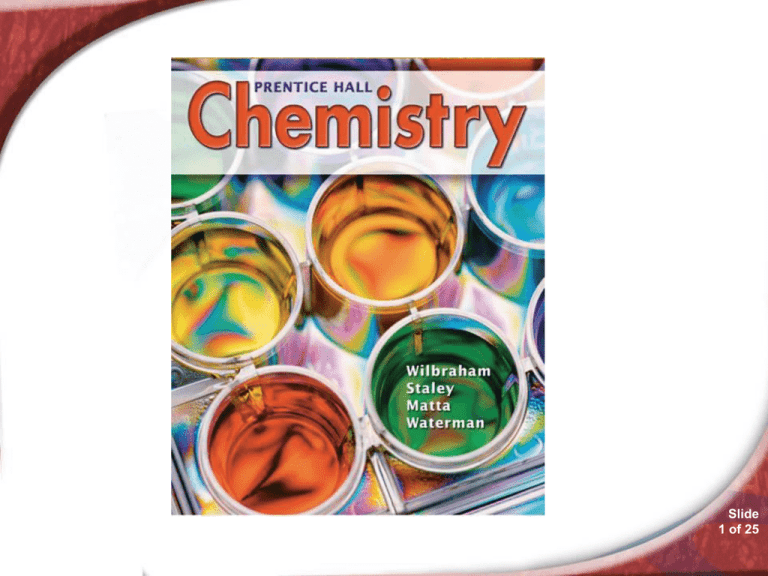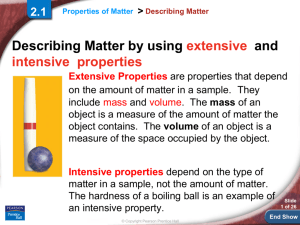
Chemistry 1.3
Slide
1 of 25
Thinking Like a Scientist
>
Learning Target
I can discuss the steps involved in
the scientific method.
Slide
2 of 25
© Copyright Pearson Prentice Hall
Thinking Like a Scientist
>
Vocabulary
Scientific method
Hypothesis
Observation
Experiment
Manipulated variable
Independent variable
Responding variable
Dependent variable
Theory
Scientific law
Slide
3 of 25
© Copyright Pearson Prentice Hall
1.3
Thinking Like a Scientist
>
The Scientific Method
The Scientific Method
What are the steps in the scientific
method?
Slide
4 of 25
© Copyright Pearson Prentice Hall
1.3
Thinking Like a Scientist
>
The Scientific Method
The scientific method is a logical, systematic
approach to the solution of a scientific problem.
Steps in the scientific method include
making observations, testing
hypotheses, and developing theories.
Slide
5 of 25
© Copyright Pearson Prentice Hall
1.3
Thinking Like a Scientist
>
The Scientific Method
Making Observations
When you use your
senses to obtain
information, you make an
observation.
Suppose you try to turn on
a flashlight and it does not
light. An observation can
lead to a question: What’s
wrong with the flashlight?
Slide
6 of 25
© Copyright Pearson Prentice Hall
1.3
Thinking Like a Scientist
>
The Scientific Method
Testing Hypotheses
A hypothesis is a proposed explanation for an
observation.
You guess that the flashlight needs new
batteries. You can test your hypothesis by putting
new batteries in the flashlight. If the flashlight
lights, you can be fairly certain that your
hypothesis is true.
Slide
7 of 25
© Copyright Pearson Prentice Hall
1.3
Thinking Like a Scientist
>
The Scientific Method
An experiment is a procedure that is used to
test a hypothesis. When you design experiments,
you deal with variables, or factors that can
change.
• The variable that you change during an
experiment is the manipulated variable, or
independent variable.
• The variable that is observed during the
experiment is the responding variable, or
dependent variable.
Slide
8 of 25
© Copyright Pearson Prentice Hall
1.3
Thinking Like a Scientist
>
The Scientific Method
Developing Theories
Once a hypothesis meets the test of repeated
experimentation, it may become a theory.
• A theory is a well-tested explanation for a
broad set of observations.
• A theory may need to be changed at some
point in the future to explain new observations
or experimental results.
Slide
9 of 25
© Copyright Pearson Prentice Hall
1.3
Thinking Like a Scientist
>
The Scientific Method
Scientific Laws
A scientific law is a concise statement that
summarizes the results of many observations
and experiments.
A scientific law doesn’t try to explain the
relationship it describes. That explanation
requires a theory.
Slide
10 of 25
© Copyright Pearson Prentice Hall
1.3
Thinking Like a Scientist
>
The Scientific Method
Steps in the Scientific Method
Slide
11 of 25
© Copyright Pearson Prentice Hall
1.3
Thinking Like a Scientist
>
Collaboration and Communication
Collaboration and Communication
What role do collaboration and
communication play in science?
Slide
12 of 25
© Copyright Pearson Prentice Hall
1.3
Thinking Like a Scientist
>
Collaboration and Communication
No matter how talented the players on a team,
one player cannot ensure victory for the team.
Individuals must collaborate, or work together, for
the good of the team.
When scientists collaborate and
communicate, they increase the
likelihood of a successful outcome.
Slide
13 of 25
© Copyright Pearson Prentice Hall
1.3
Thinking Like a Scientist
>
Collaboration and Communication
Collaboration
Scientists choose to collaborate for different
reasons.
• Some research problems are so complex that
no one person could have all of the
knowledge, skills, and resources to solve the
problem.
• Scientists might conduct research for an
industry in exchange for equipment and the
time to do the research.
Slide
14 of 25
© Copyright Pearson Prentice Hall
1.3
Thinking Like a Scientist
>
Collaboration and Communication
Collaboration isn’t always a smooth process.
You will likely work on a team in the laboratory. If
so, you may face some challenges. But you can
also experience the benefits of collaboration.
Slide
15 of 25
© Copyright Pearson Prentice Hall
1.3
Thinking Like a Scientist
>
Collaboration and Communication
Communication
Scientists communicate
face to face, by e-mail, by
phone, and at international
conferences.
Scientists publish their
results in scientific
journals. Articles are
published only after being
reviewed by experts in the
author’s field.
Slide
16 of 25
© Copyright Pearson Prentice Hall
1.3 Section Quiz.
Assess students’ understanding
of the concepts in Section 1.3.
Continue to:
-or-
Launch:
Section Quiz
Slide
17 of 25
© Copyright Pearson Prentice Hall
1.3 Section Quiz.
1. Lavoisier is credited with transforming chemistry
from a science of observation to a science of
a. speculation.
b. measurement.
c. hypotheses.
d. theories.
Slide
18 of 25
© Copyright Pearson Prentice Hall
1.3 Section Quiz.
2. A hypothesis is
a. information obtained from an experiment.
b. a proposed explanation for observations.
c. a concise statement that summarizes the
results of many of experiments.
d. a thoroughly tested explaination for a
broad set of observations.
Slide
19 of 25
© Copyright Pearson Prentice Hall
1.3 Section Quiz.
3. Why are articles in scientific journals the most
reliable source of information about new
scientific discoveries?
a. The articles are reviewed by experts in the
author's field.
b. Any article that is submitted is published.
c. Everyone has access to the information.
d. The articles are short and easy to read.
Slide
20 of 25
© Copyright Pearson Prentice Hall
END OF SHOW








